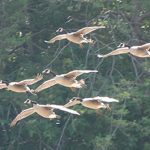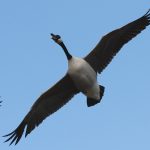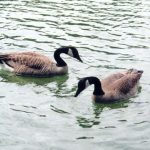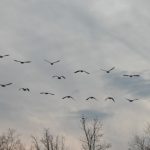Canada Goose
Branta Canadensis
For nuisance control of Canada Geese click here.
The Canada Goose (Branta canadensis) belongs to the Branta genus of geese, which contains species with largely black plumage, distinguishing them from the grey species of the Anser genus. The species name, canadensis, is a New Latin word meaning “of Canada”. The black head and neck with white “chinstrap” distinguish this goose from all except the Barnacle Goose, but the latter has a black breast, and grey, rather than brownish, body plumage. There are seven subspecies of this bird, of varying sizes and plumage details, but all are recognizable as Canada Geese. Some of the smaller races can be hard to distinguish from the newly-separated Cackling Goose. This species is 76-110 cm (30-43 in) long with a 127-180 cm (50-71 in) wingspan. Males usually weigh 3.2–6.5 kg, (7–14 pounds), and can be very aggressive in defending territory. The female looks virtually identical but is slightly lighter at 2.5–5.5 kg (5.5–12 pounds), generally are 10% physically smaller than their male counterparts and has a different honk. An exceptionally large male of the race B. c. maxima, the Giant Canada Goose (which rarely exceed 8 kg/17.6 lbs), weighed 11.3 kg (25 pounds) and had a wingspan of 224 cm (88 inches). The average life span in the wild is 10-25 years. These birds feed mainly on plant material. When feeding in water, they submerge their heads and necks to reach aquatic plants, sometimes tipping forward like a dabbling duck. They depend largely on grasses, sedges, or other green monocots during summer. Flocks of these geese also often feed on leftover cultivated grains in fields, especially during migration or in winter. Corn may comprise almost the whole seasonal diet of some migrants. During the second year of their lives, Canada Geese find a mate. Most couples stay together all of their lives. If one is killed, the other may find a new mate. The female lays 4-8 eggs and both parents protect the nest while the eggs incubate, but the female spends more time at the nest than the male. Known egg predators include Arctic Foxes, Red Foxes, all large gulls, Common Raven, American Crows, and bears. During this incubation period, the adults lose their flight feathers, so that they cannot fly until after their eggs hatch. This stage lasts for 25-28 days. Adult geese are often seen leading their goslings in a line, usually with one parent at the front, and the other at the back of the “parade”. While protecting their goslings, parents often violently chase away nearby creatures, from small blackbirds to other geese, to humans that approach, after warning them by giving off a hissing sound. Most of the species that prey on eggs will also take a gosling if there’s an opportunity. However, geese may form groups of a number of goslings and a few adults, called crèches. The offspring enter the fledging stage anytime from 6 to 9 weeks of age. The young do not leave their parents until after the spring migration when they return to their birthplace. Once they reach adulthood, Canada Geese are rarely preyed on but can be taken by Coyotes, Red Foxes, Gray Wolves, Snowy Owls, Great Horned Owls, Golden Eagles and, most often, Bald Eagles. This well-known species is native to North America. It breeds in Canada and the northern United States in a variety of habitats. However, the nest is usually located in an elevated area near water, sometimes on a beaver lodge. The eggs are laid in a shallow depression lined with plant material and down. The Great Lakes region maintains a very large population of Canada Geese. Like most geese, the Canada goose is naturally migratory with the wintering range being most of the United States. The calls overhead from large groups of Canada Geese flying in V-shaped formation signal the transitions into spring and autumn. In some areas, migration routes have changed due to changes in habitat and food sources. In mild climates, such as the Pacific Northwest, due to a lack of former predators, some of the population has become non-migratory. Through different areas of North America, non-migratory Canada Goose populations have been on the increase. They frequent golf courses, parking lots and urban parks, which would have previously hosted only migratory geese on rare occasions. Their adaptability to human-altered areas has made this the most common waterfowl species in North America. In many areas, these non-migratory Canada Geese are now regarded as “pests”. They are suspected of being a cause of an increase in high fecal coliforms at beaches.[citation needed] An extended hunting season and the use of noisemakers have been used in an attempt to disrupt suspect flocks over the course of several years. The text within the green border is licensed under the GNU Free Documentation License. To see the full article with more information, visit the Wikipedia article “Canada Goose“. All content outside the green border is copyrighted by McBryde Website Design. |
For more information from the USGS (United States Geological Survey)
on the Canada Geese, click here.







